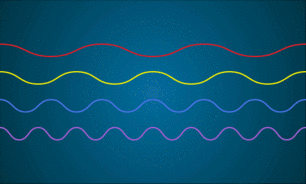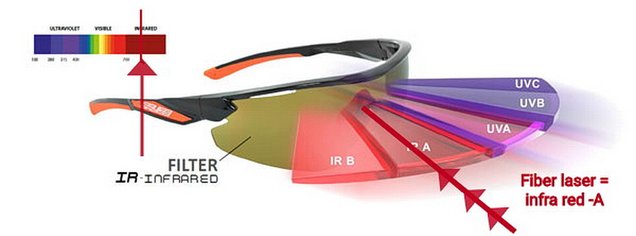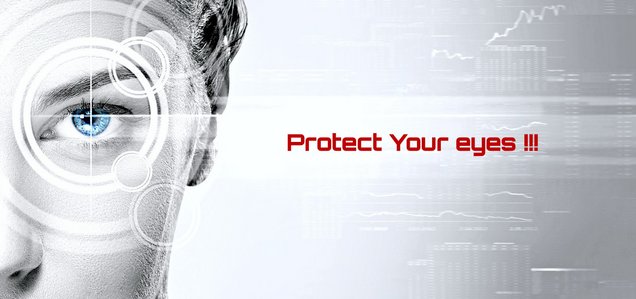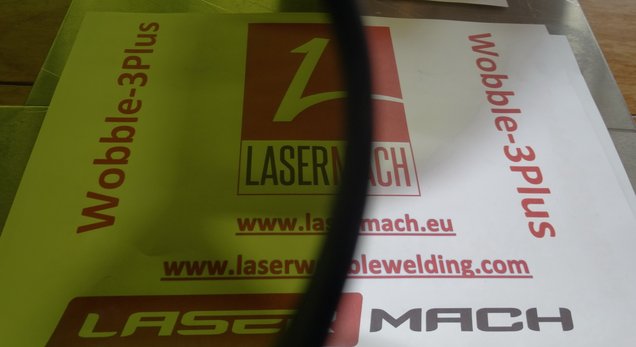Click HERE to visit our new PhotonWeld Website
All latest info on ourPhotonweld Series of laser welding machines here to find
Why Laser Safety Glasses?
The Ugly Truth About Laser Radiation Exposure
In the time that it takes to blink an eye, laser radiation damage to the eye may have already occurred. Unprotected exposure to lasers can result in the development of cataracts or even a corneal burn, which can result in vision loss.
If you are working with or around lasers, it is very important to understand the consequences of laser radiation exposure and the safety precautions you should take when working around them.

Laser Wavelengths
Just like ordinary light, laser beams come in all colors. They measure light in nanometers (nm), the light’s wavelength.
There are three main ranges of light wavelengths:
* Ultraviolet – 100-400 nm
* Visible – 440-750 nm - The visible range of laser light goes from violet to red just like a rainbow.
* Infrared – 750nm to 1mm (Laser Welding frequency belongs to the IR-light range (Infra-Red)
Infrared lasers pose a particular hazard. Because they cannot be seen, they do not trigger the eye’s blink reflex.
Our Welding Lasers use the dangerous Infrared laserlight

Danger of Laser radiation
Lasers used for laser welding applications radiate in the infrared spectra, which are not visible to the humaneye. The intensive fiber laser light radiate in the visible spectrum but invisible for humans, is especially dangerous to the eye. Fibre laser radiation penetrate through to the retina which can be destroyed irrevocably by relatively little radiation.
Misdirected laser radiation can come directly from the laser and threaten the eyes as a result of a faulty parameter setting, an opened cover, a displaced mirror etc. Other hazards include skin burn or inflammation from combustible materials as a result of misdirected laserradiation. The greatest hazard, however, usually stems from reflected laser radiation: the major share of the laser radiation is reflected by coldmaterial first. To this we can add reflections of work piece edges, as a result of turbulence in the weld pool etc.
Misdirected radiation and reflections must be blocked off. That is why the law stipulates that the laser beam and the work zone must be in an enclosure. Beyond that, all those present, and the machine operators in particular, should wear protective goggles that are appropriate for the laser radiation being used. Fbre laser radiation are very dangerous to the eye and require special protective measures andapproved safety goggles.
Standard protective welding goggles made of glass or acrylic glass are not suitable at all,
as glass and acrylic glass allow fibre laser radiation to pass through!
Laser safety: Laser protection class 4 applies to our Wobble manual laser welding equipment when in operation.
Wobble Laser Welding Series = Class 4
This class 4 covers most powerful and dangerous lasers. Class 4 lasers can cause permanent eye injury through either direct exposure or reflected light. They can also burn the skin and cause fires. ALL lasers used in welding industry, surface cleaning industry and metal cutting industry are Class 4.
Different measures are therefore required on the customer side to ensure laser safety, such as the appropriate training of employees, wearing special protective equipment and setting up a separate laser safety area.

Never use coated protection Glasses
Every little scratch let full acces to your eye!!
Use only fully coloured lenses, with fully protection in the lenses itself.
Never use coated glasses as the slightest scratch in the coating makes your glases unsafe and not more usable!
Don't let your eyes destroy by cheaper but coated safety glasses!!
Every Wobble+ and Wobble-PRO+ comes with 2 pairs of PREMIUM protection glasses.
Laser Eyewear: Quality lenses gives quality view - Do not go for less!!

Wobble+ and Wobble-PRO+ Series belong to Class 4
Lasermach WOBBLE Series = LASER RADIATION CLASS 4
This is the highest class of laser radiation. Radiation in this class is very dangerous, and viewing of the diffuse reflection may be dangerous. Class 4 laser beams are capable of setting fire to materials onto which they are projected.

Keeping an eye on safety
We do care about your eyes!
Easy to wear protection glasses - Comparable to comfortable sunglasses
Full protection of the eyes - Great view!
Finaly you can weld and see what you do before, during and after the welding!

Laser Safety: Under EN 60825-1 classification scheme, lasers are classified into seven hazard classes depending on the accessible emission limits.
The scheme is a measure of the laser’s ability to produce injuries to personnel.
The classes are as follows:
-
Class 1: the radiation is not dangerous and no protection equipment needed
-
Class 1M: the radiation is not dangerous when used without optical instruments but may become dangerous when used in combination with optical instruments - no protective equipment required if used without optical instruments
-
Class 2: The radiation emitted is not dangerous due to aversion responses including the blink reflex – no protective equipment needed
-
Class 2M: The radiation emitted is not dangerous due to aversion responses including the blink reflex but may become dangerous when used with optical instruments - no protective equipment required if used without optical instruments
-
Class 3R: The radiation from these lasers exceeds the maximum permissible exposure values so is dangerous to the eyes and safety glasses are recommended
-
Class 3B: Direct laser view is dangerous so safety glasses are mandatory ⇒ fiber laser welding
-
Class 4: Both direct and diffuse radiation is dangerous so personal safety equipment is necessary ⇒ all handheld fiber laser welding machines and laser cleaning Machines
Difference Between Optical Density and Absorbance
For absorbance measurements, the optical density (O.D.) is a logarithmic measurement of the percent transmission (%T) and it can be represented by the equation, A = log10 100 / %T.
The key difference between optical density and absorbance is that the optical density measurement takes both, the absorption and scattering of light, into consideration whereas absorbance measurement takes only the absorption of light into consideration. Optical density (OD) is the degree to which a refractive medium retards transmitted rays of light while absorbance is a measure of the capacity of a substance to absorb light of a specified wavelength.
That means a protection goggle with:
- 1 O.D. allows 10% of light to be transmitted through the sample
- 2 O.D. allows 1% of light to be transmitted through the sample
- 3 O.D. allows 0.1% of light to be transmitted through the sample
- 4 O.D. allows 0.01% of light to be transmitted through the sample
In other words, if a protection goggle has an O.D. (Optical Density) equal to 3, this means that only 1 photon of light out of 1,000 (10³) will be pass thru the protection goggle, if it has an O.D. equal to 7, this means that only 1 photon of light out of 10.000.000 will be pass thru the protection goggle. This means the light passing thru will be 1000 or 10.000.000 times less for the frequency indicated.
VISIBLE LIGHT TRANSMISSION (VLT)
When deciding which kind of lenses to purchase, a good place to start is with the visible light transmission (VLT). The higher the VLT percentage is, the lighter the lens tint will be. Higher VLT percentage lenses will allow for more light to travel through the lens that will then hit the eye. Alternatively, lenses with a lower VLT percentage will have a darker tint and will block more light from coming through to the eye.
Visibility Light Transmission (VLT) – Color and visibility of specific color ranges often are significantly affected by laser glasses and goggles. Think about sunglasses - when wearing sunglasses to block the sun, (often less expensive) sunglasses do an effective job of blocking the sun. However, everything is much more difficult to see because not a lot of light generally is coming through. Other times with (typically more expensive) sunglasses, the sun is blocked and everything else looks very similar to how it would without the glasses. We have selected the lenses with the highest VLT % with the highest protection possible for your Eyes and giving the nicest and clearest view of the objects.
Rules of conduct on the safe use of lasers
The following rules are of particular importance:
- Never point the laser beam at anyone’s eyes!
- Do not look directly into a laser beam!
- Always wear protection glasses!
- If the laser light accidentally strikes your eyes, close your eyes and immediately move your head out of the laser beam.
- Do not use any focusing optical device to look at the laser beam while working with lasers.


